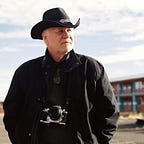Is There a Relationship Between Color and Sound?
And if there is, can photographers take advantage of it?
Have you ever been riding with the windows down, wind blowing in your face, jammin’ to a favorite tune, and suddenly, BAM, a burst of color fills your mind? It’s like your favorite track, (Separate Ways? Koln Concert? O Mino Babbino Caro?), just snapped a photo in your head, and you’re thinking, “Whoa, that’s cool!”
Sounds wild.
But it’s real — it’s a real phenomenon.
This magical crossover of senses is known as synesthesia, specifically chromesthesia.
Those are some sophisticated scientific words right there.
Now, you might be wondering, “Why should I care, Don, I’m a photographer, not a composer.”)
Well, buckle up, buttercup, because the connection between color and sound is not just some fantasy fluff — it’s backed by science, and it can seriously change how you experience the world. It may even give you something to think about while making images.
The Science Behind the Magic
Waves. That’s the common thread.
Color comes from light waves.
Sound comes from, well, sound waves.
These waves are different in frequency — light waves are way faster than sound waves.
Visible light frequencies? We’re talking about 400–790 terahertz (THz).
Audible sound? Just a humble 20 Hz to 20,000 Hz.
So there are a lot more frequencies in color than in sound, although we interpret them far differently.
Also, our brains and bodies process these waves in surprisingly different ways.
Eyes vs. Ears.
Our eyes can see only about one octave of visible light, mainly focusing on red, green, and blue. Our ears?
Ears are like those overachievers we envied in school, sensing vibrations across ten octaves of sound.
Newton’s Colorful Notes
This fascination with color and sound isn’t new.
Way back in the 17th century, Isaac Newton played matchmaker between the colors of the rainbow and musical notes. And he wasn’t alone. In the 18th century, Louis-Bertrand Castel tried to build a “color harpsichord” that played music and showed matching colors.
Sounds like a fun party trick, but it was serious business!
The New Frontier
Fast forward to today, and researchers are still diving deep into the color-sound connection.
(Can you imagine their holiday parties? I tingle with muted orange just trying to picture it.)
High pitches seem to relate to bright colors
Loud sounds bring brighter, more saturated colors
The energy distribution in a sound influences the color you might “see.”
These aren’t just random and bizarre ideas. Studies show that some color-sound pairings are pretty automatic for most people. High pitches almost always feel brighter, and louder sounds just seem more colorful.
Think of the music we listen to and how we feel about it.
In film scores, bassoons, cellos, and basses are used for those dark, mysterious moments, while flutes, clarinets, and oboes bring in the light.
Fast music is usually used in brighter scenes, while slower music is used for romance, mystery, and scenes where they split up to find the cat while the spaceship is being destroyed by a steel-chewing monster.
(Pro tip; never split up, that’s just stupid, and the cat can fend for itself.)
Note the colors and scenes in the imagery, while the instruments and score use these very concepts to drive the narrative in this study of “The Lord of the Rings” score:
https://youtu.be/XLj6zkmwsYU?si=kfiq5jhOdF-Erq8v
A Cultural Twist
It’s not all black and white (or red and green, or Pavillion White and Pirate Cove Blue; hey, I’m looking for wall paint for the casita… it’s on my mind.).
Culture, personal experiences, and even context shape how we link colors and sounds. So, what feels like a bright yellow note to you might be a mellow blue to someone else. And that’s OK. We are not sound/color bosses.
The unique properties we bring to our work could be expressed in color and sound.
I have always heard music when looking at photographs.
Occasionally, those will be snippets of various genres, and sometimes I hear something of my own making.
In essence, the dynamic between color and sound is a blend of physics, psychology, and just a wee touch of magic.
Look, if you’re a photographer looking for inspiration or just someone who loves music, this relationship opens up new ways to experience and enjoy the world around you.
So next time you hit play on that super-boss boom box with the light-up 8-track drawer, close your eyes and see what colors come to life.
And here’s an assignment for you:
Photograph the sound of:
1. A trumpet
2. Heavy metal guitar riff
3. The trickling sound of a small waterfall
4. The wind
5. The Oompa Loompa song
Good luck, and be happy I didn’t mention “It’s a Small Small World” and get that earworm started, heh. Oh wait… sorry.
Hi, I’m Don Giannatti, a photographer and mentor for up-and-coming photographers. You can find me on my website, Don Giannatti, and at my Substack site, where I also publish for creative people.
